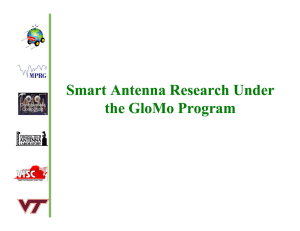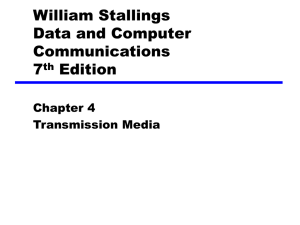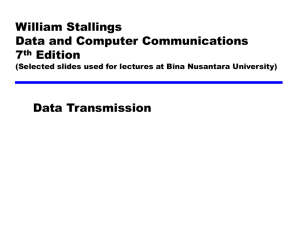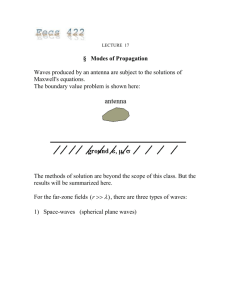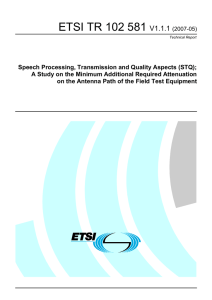Sistem Jaringan Komunikasi Data
advertisement
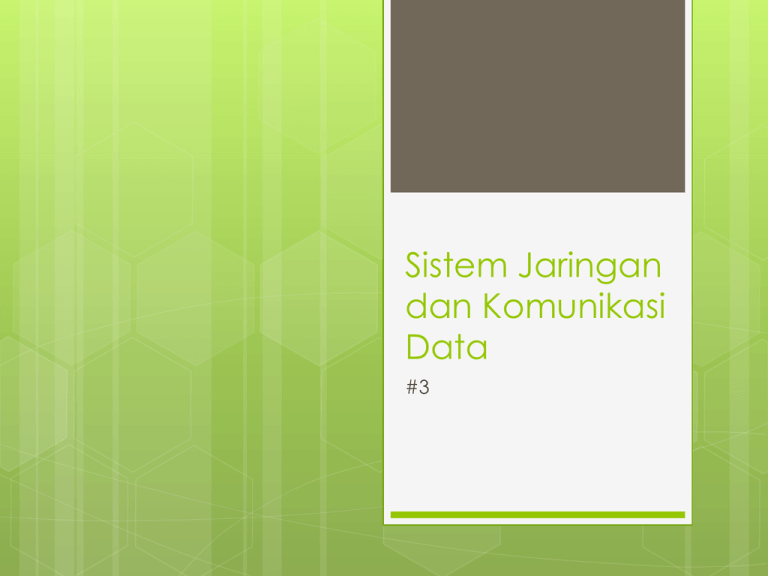
Sistem Jaringan dan Komunikasi Data #3 Overview guided - wire / optical fibre unguided - wireless characteristics and quality determined by medium and signal in unguided media - bandwidth produced by the antenna is more important in guided media - medium is more important key concerns are data rate and distance Design Factors bandwidth higher bandwidth gives higher data rate transmission impairments eg. attenuation interference number of receivers in guided media more receivers introduces more attenuation Electromagnetic Spectrum Guided Media Twisted Pair Coaxial cable Optical Fiber Twisted Pair Twisted Pair - Transmission Characteristics analog needs amplifiers every 5km to 6km digital can use either analog or digital signals needs a repeater every 2-3km limited distance limited bandwidth (1MHz) limited data rate (100Mbps) susceptible to interference and noise Unshielded vs Shielded TP unshielded Twisted Pair (UTP) ordinary telephone wire cheapest easiest to install suffers from external EM interference metal braid or sheathing that reduces interference more expensive harder to handle (thick, heavy) shielded in Twisted Pair (STP) a variety of categories - see EIA-568 UTP Categories Category 3 Class C Category 5 Class D Category 5E Category 6 Class E Category 7 Class F Bandwidth 16 MHz 100 MHz 100 MHz 200 MHz 600 MHz Cable Type UTP UTP/FTP UTP/FTP UTP/FTP SSTP Link Cost (Cat 5 =1) 0.7 1 1.2 1.5 2.2 Coaxial Cable Coaxial Cable - Transmission Characteristics superior frequency characteristics to TP performance limited by attenuation & noise analog signals amplifiers every few km closer if higher frequency up to 500MHz digital signals repeater every 1km closer for higher data rates Optical Fiber Optical Fiber - Benefits greater capacity data rates of hundreds of Gbps smaller size & weight lower attenuation electromagnetic isolation greater repeater spacing 10s of km at least Optical Fiber Transmission Modes Wireless Transmission Frequencies 2GHz to 40GHz microwave highly directional point to point satellite omnidirectional broadcast radio 30MHz 3 to 1GHz x 1011 to 2 x 1014 infrared local Antennas electrical conductor used to radiate or collect electromagnetic energy transmission antenna radio frequency energy from transmitter converted to electromagnetic energy by antenna radiated into surrounding environment reception antenna electromagnetic energy impinging on antenna converted to radio frequency electrical energy fed to receiver same antenna is often used for both purposes Radiation Pattern power radiated in all directions not same performance in all directions as seen in a radiation pattern diagram an isotropic antenna is a (theoretical) point in space radiates in all directions equally with a spherical radiation pattern Antenna Gain measure of directionality of antenna power output in particular direction verses that produced by an isotropic antenna measured in decibels (dB) results in loss in power in another direction effective area relates to size and shape related to gain Terrestrial Microwave used for long haul telecommunications and short point-to-point links requires fewer repeaters but line of sight use a parabolic dish to focus a narrow beam onto a receiver antenna 1-40GHz frequencies higher frequencies give higher data rates main source of loss is attenuation distance, also rainfall interference Satellite Microwave satellite is relay station receives on one frequency, amplifies or repeats signal and transmits on another frequency eg. uplink 5.925-6.425 GHz & downlink 3.7-4.2 GHz typically height of 35,784km spaced at least 3-4° apart typical requires geo-stationary orbit uses television long distance telephone private business networks global positioning Satellite Point to Point Link Satellite Broadcast Link Broadcast Radio radio is 3kHz to 300GHz use broadcast radio, 30MHz - 1GHz, for: FM radio UHF and VHF television is omnidirectional still need line of sight suffers from multipath interference reflections from land, water, other objects Infrared modulate noncoherent infrared light end line of sight (or reflection) are blocked by walls no licenses required typical uses TV remote control IRD port Wireless Propagation Ground Wave Wireless Propagation Sky Wave Wireless Propagation Line of Sight Line of Sight Transmission Free space loss loss of signal with distance Atmospheric Absorption from water vapour and oxygen absorption Multipath multiple interfering signals from reflections Refraction bending signal away from receiver Multipath Interference Data Com Components Message Transmitter Receiver Medium Protocol A Communications Model Communications Tasks Transmission system utilization Addressing Interfacing Routing Signal generation Recovery Synchronization Message formatting Exchange management Security Error detection and correction Network management Flow control Data Communications Model


